the concept of a bird's wing
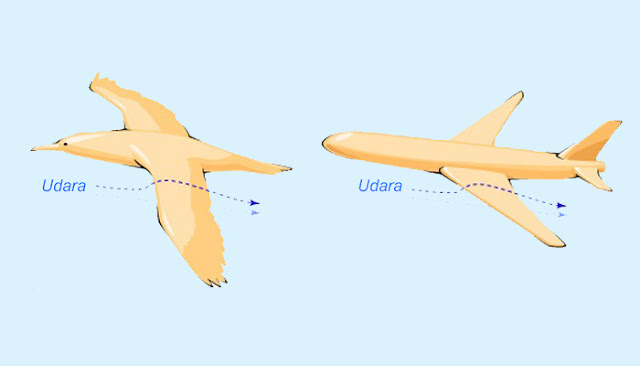
X . I
Why Birds Can Fly?
Since time immemorial, man has been watching birds fly and wondered how they could do it. The studies done to find out the secret of how birds can fly. Observation and research subsequently made man could make a flying machine called the aircraft.
Birds have a lot of things in the body that can make it fly. It looks like the bird was set up to be animals that can float in the air. Although there are several types of bird family members who do not have the ability to fly like a penguin, chicken, dodo, and ostrich.
Why Birds Can Fly?
From the biology of birds able to fly because it has several factors, including:
1. Wings, functioning lift her into the air.
2. Bones and lightweight frame composition compared to other living beings.
3. The muscles strong chest and stretched its wings to flap, so it can withstand the pressure of the air.
4. Bone big and heavy on the chest and shoulders, to supplement the strength of the wings of birds.
5. purse air in his body, functioning regulate breathing and keep the bird's body to keep it light.
6. Feathers to hold air.
In terms of physics, the ability to fly the bird to come by because the birds were able to do some things in:
1. aeoro foil shaped wings.
2. Being able to generate pressure on the air under its wings.
How Do Birds Fly?Birds get upward lifting force to push himself up with his feet and flapping its wings. When a bird's wings flapping, the air will be pushed down. This push-down will produce the opposing forces so that the bird's body will be lifted into the air. This principle is in accordance with Newton's Law 3. Lift up is usually referred to as a lift.
Trust or thrust forward serves to increase the speed of flying birds is also produced from flapping. In some bird species is obtained from the speed wingspan developed. Increasingly wingspan greater the speed of flying birds. Birds with small wings gain flying speed of the speed of their flapping wings.
Tails in birds serves to accelerate when flying. By leveraging could turn tail and swooping birds. Another function of the birds is as landing aids. When birds straightened and develop wings and tail, the air will be captured, allowing the birds to land softly.
X . II
the effect of flying owl
No privilege owls catch their prey without sounding.
"Owls hunt at night, that's all visual information is limited because of the darkness," Therefore owl has excess detect prey to the sense of hearing, it only works if they fly not ring. "
owl wing aerodynamics research. He discovered, it turns out the birds Hoarse Java or white owl weighs almost the same as doves. But the wings are larger and thicker hairy. "It allows the bird to remain afloat in the air even in low-speed flight," he continued.
Pigeons should be more often flapping its wings. Therefore, the sound of pigeons flying can already be heard from a distance. In contrast to the owl almost no friction between hairs, and it has fewer sounds.
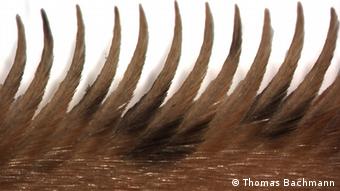
cross-section of the front side of the wing owl
Sharks Effect On owl
Owl feather structure is also different from other types of bird feathers. On the front side of the wing, fur lined up and formed a line like hooks. The surface was very soft bristles create micro turbulence on the surface of the wing.
delicate tassels on the end of a feather
delicate tassels on the end of a feather
Similar to shark skin rough surface that minimizes friction with water, micro turbulence increases the stickiness of the airflow on the surface of the wing owl.
Then there are tassels on the ends of the feathers. Its function is to minimize the noise, because each feather each other more refined ride. The other function is more subtle friction between the air flow with the top and bottom in the rear wing on the delicate tassels.
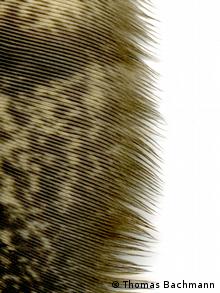
delicate tassels on the end of a feather
Jet Aircraft Modelling Stork
Privileged owl wings could not easily be applied to the construction of civil passenger aircraft. One reason is the speed to fly owl hunting only ten to 15 km / h. But the physical principles can be directly transferred to the aviation technology. For example in the development of vane windmill or turbine with virtually noiseless.
In contrast, more aircraft technology uses the principle of a bird's wings to fly other types. For example winglets at the wing tips of commercial aircraft. Small vertical fin on the wing tips are useful to keep separate the high pressure on the underside of the wing and low pressure at the top of the wing that had to be met at the end of the wing and cause turbulence and slowing the pace of aircraft.
Small indentations on the wingtips were created by imitating the wings of vultures, eagles and storks. "These birds have feathers that grow in line. By doing so, each end of the bristles break up the edge vortex of air and reduce drag wing,".
Find prey with Asymmetric Sense Hearing
Owl proved to be able to fly almost noiseless. In finding prey, owls oriented senses of hearing by utilizing a flexible layer composed of short hairs that covered his face circumference. The layer serves as a sound reflector pieces. Owls have ear hole layout arrangement is not symmetrical, not the same height and with different angles. One pointing up, one pointing down. Completeness of hearing as it makes owls have sensitive hearing and are pointing towards the sound source.CT image of the bones of the head owl
CT image of the bones of the head owl
These principles can also be used for video conferencing technology. One camera always point to the person who is speaking. "If there are more people speaking, the camera automatically lead to that person,"When the number of conference participants to speak simultaneously, a camera control system which is inspired from the owl was still able to maintain attention. "Separation of the source was not easy, but the white owl could do it. He has the ability to control his attention," said Wagner and described the situation as a cocktail party effect. "When a lot of people talking in a cocktail party, we can still maintain attention on the person speaking, white owl also can be,".
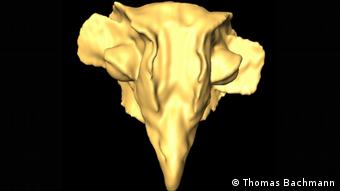
CT image of the head of an owl
X . III
attractions physics concept flying in the air
In everyday life Bernoulli's Law has a diverse application of that has to do with the flow of fluid, either liquid or gas flow. Implementation was used mostly in the fields of engineering and science related to fluid flow. For example in aircraft technology Bernoulli's Law is being used to design an airplane wing design. In other areas, for example the design of the form of fuel-efficient cars, ships and some measuring devices to be used in a speed controller equipment and so on.
Style Lift Aircraft
The airplane has a wing-like shape of the wings of birds, which is curved and thicker at the front than at the back. This is called the shape of the wing airfoil. Unlike bird wings, wing aircraft can not be in the flap - flutter. Therefore, the air must be maintained through both wings of an airplane. This is done by moving the aircraft engine aircraft developed to meet the air. Aircraft engine old propeller engines, while the use of modern jet engines. Aircraft may be lifted upwards when the lifting force is greater than the weight of the aircraft.We will discuss the lifting force on an airplane wing using the Bernoulli equation. For that, we consider the form of an airplane wing such that current lines airflow through the wing is fixed (streamlined). Cross section of an airplane wing has a sharper rear and side parts of more curved than the bottom. This shape causes the airflow at the top is greater than at the bottom (v2> v1).Of the Bernoulli equation we get:
P1 + ½ + ρ g ρ.v12 h1 = P2 + ½ + ρ g h2 ρ.v22
Altitude both wings can be considered equal (h1 = h2), so that ρ = ρ g g h1 h2. And the above equation can be written:
P1 + P2 + ½ ρ.v12 = ½ ρ.v22
P1 - P2 = ρ.v22 ½ - ½ ρ.v12
P1 - P2 = ½ ρ (v22 - v12)
From the equation above it can be seen that v2> v1 we get P1> P2 to wing section area F1 = P1. A and F2 = P2. A and we get that F1> F2. Different styles on the bottom and top (F1 - F2) produces lift on the aircraft. Thus, the lifting force plane is defined as:
F1 - F2 = ½ ρ A (v22 - v12)With ρ = density of air (kg / m3).
Style-style are Working on AircraftFrom some of the things, the good performance of pilots on a flight depends on the ability to plan and coordinate the use of energy (power) and control of the aircraft to change the style of thrust (thrust), style hold (drag), lift (elevator) and the weight of the aircraft (weight). The balance of forces is exactly what should be controlled by the pilot. The better understanding of the forces and their control, the better the skills of a pilot.Here are the things that define these forces in a low straight and flat, not accelerated (stright and level, un accelerated).Thrust, is thrust, generated by the engine (power plant) / propeller. This style is the opposite of the resistant force (drag). As a general rule, thrust into action parallel to the longitudinal axis. However, this is not always the case.Drag, is the force behind, withdraw, and is caused by disruption of air flow by the wing, fuselage, and other objects. Drag opposes thrust, and acts rearward parallel to the relative wind (relative wind).Weight, gravity is the combined weight of the load of the airplane, crew, fuel, and cargo or luggage. Weight pulls the plane down because of gravity. Weight against elevator (lift) and acts vertically downward through the center of gravity of the aircraft.Lift, (lift) against the force of the weight, and is produced by the dynamic effect of the air acting on the wing, and acts perpendicular to the direction of flight through the center of lift of the wing.In steady flight, the amount of force that is opposing is equal to zero. There will be no imbalance in steady flight and straight (Newton's third law). This applies to horizontal flight or climbing or descending. This is not the same as saying the four forces are equal. Simply put all the opposing forces are equal and cancel out the effect of each style. Often the relationship between these four forces described by one or illustratedin such a way that it becomes less clear.Consider the following picture as an example. In the illustration at the top, the value of all vector-style look the same. The usual explanation states (without stating that thrust and drag do not equal weight and lift) that thrust .

equals drag and lift equals weight as shown in the illustration below.Basically this is a true statement that should really be understood or would give a misleading notion.It should be understood that in a straight and horizontal flight (straight and level), - no berakselerasi-, is a true force lift / weight opposites are the same, but the style was also greater than the opposing force of thrust / drag are also equal in value between both, not compared with the lift / weight. For the truth, it must be said that in a stable state (steady):1. The amount of the upward force (not just lift) equal to the amount of downward force (not just weight)2. The amount of thrust (not just thrust) is equal to the amount of force to the back (not just drag).
Performance Flying BirdsThere are 4 types of styles involved:1. Drag Force, the air drag. This style comes from the collision of air molecules with the body of the bird. Direction of the force is always opposite to the direction of motion of birds. While the size of the force is very dependent on the surface area of birds and bird speed. The more surface area the greater the force inhibitory birds. The faster the bird moves, the greater the force of this inhibitory. An illustration to describe the drag-force (resistance) this air is perceived barriers when we walk against the wind blowing. These barriers are increasingly felt great when we open our arms wide open (extending surface of our body) or when we move faster.2. Lift Force (lift) is a style that lift the bird up. There are two things that can cause this lift force: the fluttering of wings and airflow over the wings. When birds flapping wings down, the birds of air pressing down, as a result of air will push back and push the bird up (the law of action-reaction). The faster the beating of wings, the greater the force on it. That is why pigeons take flight wings will pack an quickly. Heavy bird like Kori Bustard of Africa must necessarily have a strong chest muscles so that they can more quickly flapping wings to lift his large frame (19 kg).
air stream flowing over the top of the wing will move faster because the air must be routed further. As a result, the pressure section
This is smaller than the air pressure below the wing.
This pressure difference gives lift to the birds. more and more
curve (the more aerodynamic) wing the greater the force it up.
3. Thrust (thrust) is the force that drives the birds moving forward.
This style is generated by flapping wings that move like the number 8
fall (viewed from the side). Flapping wing generates a vortex
air (vortex) which can provide a boost for the birds
to move forward in the air. The amount of thrust is very
depending on the muscle strength to fly.
4. Weight (gravity) that the gravitational pull of the earth. The amount so
depending on the mass of birds. Its direction is vertically downward.

style style in birds during flight
The combination of all four styles have used birds to perform a variety of attractions such as parachutting (motion parachute), Gliding (gliding), flight (flying forward), and soaring (rising).Parachuting (parachute motion)Motion parachute is falling motion of the air (can be tilted can also be vertical). Tilt angle is greater than 45 ° to the horizontal line. To exercise parachute, the eagle must increase inhibitory force (drag force) way is to increase the surface area (for example, by spreading its wings).Gliding (glide)Gliding (slide) motion which falls at an angle less than 45 ° with a horizontal line. The main focus in gliding is gliding as flat as possible. This is done by reducing the air drag. In doing Fulmar bird gliding to a distance of 8.5 meters horizontally but only down 1 meter only. Vultures (Vultures) better, these birds can travel a horizontal distance 22 meters distance with drops only 1 meter.Flight (Flying)Flight movement (fly) performed by the flapping wings. flutterwings used to generate forward thrust force (thrust) and stylelift (elevator). The thrust and lift force can be set by the birds to control direction, speed, and altitude when the owl down at high speed to catch rats, owls shrink drag force to streamline his body or bend the wings. When it was close to its prey (to land), owl slowing its movement by increasing the drag force is to develop wings.Soaring (motion soar)Motion rose is a rose without flapping motion. This movement can be done using air currents. As a result of the sun heating the air temperature near the earth's surface becomes hotter, the heat will rise up and cause the air flow to the top. Air flow is utilized by an eagle to soar without beat great wings. Gulls or albatross, another. To soar, gulls utilize air currents reflected by the surface of the sea. That's why seagulls always come near to the sea surface.Why chickens can not fly properly birds?Some of the factors are as follows:1. The large size and small wings compared her size.2. Chicken body weight because their bones contain a lot of marrow, unlike the bird aviator whose bones had plenty of empty cavity.3. chicken breast muscles do not develop properly, so its ability flapping weakly.4. Birds have the coffers of the air is used to breathe while flying while chickens do not have any such desires coffers coffers
The fundamental difference between chickens and birds, chickens have a structure or arrangement of feathers on the wings are very different from the birds. In chickens, the proportion of the size of their wings (when unfolded) to the great weight and their bodies are not big enough, so with great muscular strength was difficult for them to fly. In other words, because they poultry wing lift force is smaller than the weight of the birds. Moreover, if the chicken is free-range chicken or beef, it can be guaranteed, he will not be able to lift her into the air.
Unlike the birds, birds that can fly has a wide wing structure, the composition of feathers is strong and tight, and the size of the body that is lightweight and relatively small. Some birds have small wings, hummingbird, for example. But, vibration of its wings very fast up until not visible to the eye. When the chicken can beat their wings as fast as a hummingbird, guaranteed he can fly, but the fur will fall out and fly everywhere, because it is not designed specifically chicken wings to fly.
X . IIII
Bionic Bird, Bird Drone
Now has come the drone new style that takes the form of a bird. The Drone is Bionic Bird who has the ability to fly much like a real bird.
Bionic Bird had a figure like a black bird with a wing span of up to 36 cm. To accommodate the low, such drones only weighs 90 grams.
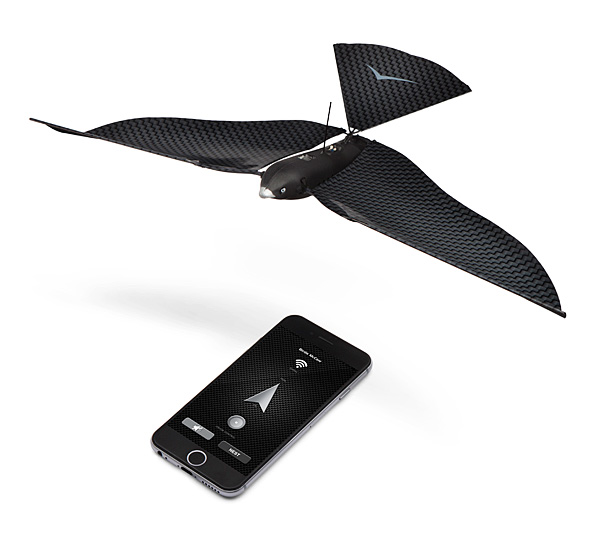
Bionic Bird can fly for 10 minutes in the air. You can control it with a smartphone connected via Bluetooth. The signal range is a maximum of 100 meters.
Drone this bird looks no different from a real bird when flying. Flapping wings and maneuverability would probably make anyone think it was not a drone.
In addition to offering low outside, Bionic Bird also allows flight in the room. No need to worry about falling or crashing because weight is so light to minimize potential damage.
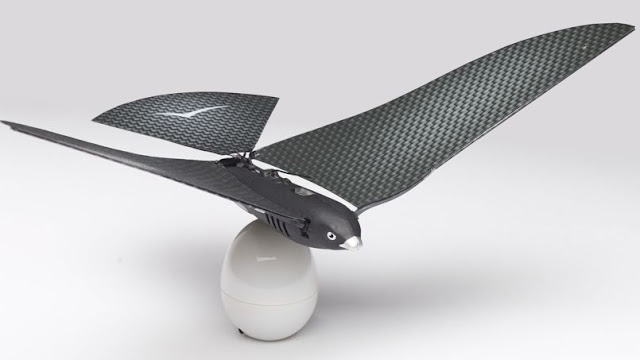
Egg-shaped portable charger for fast charging


Tidak ada komentar:
Posting Komentar